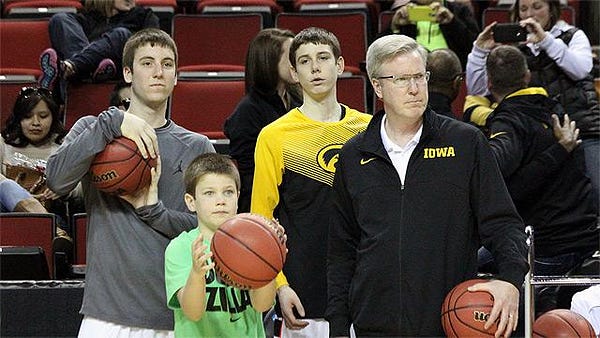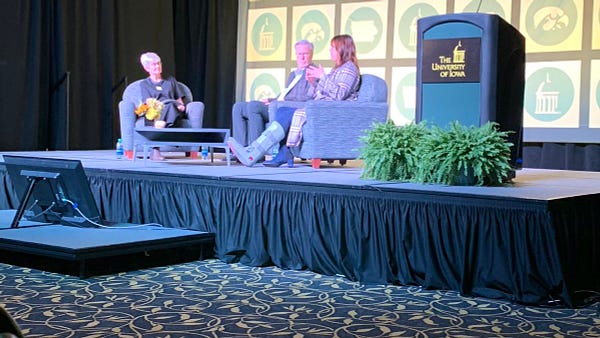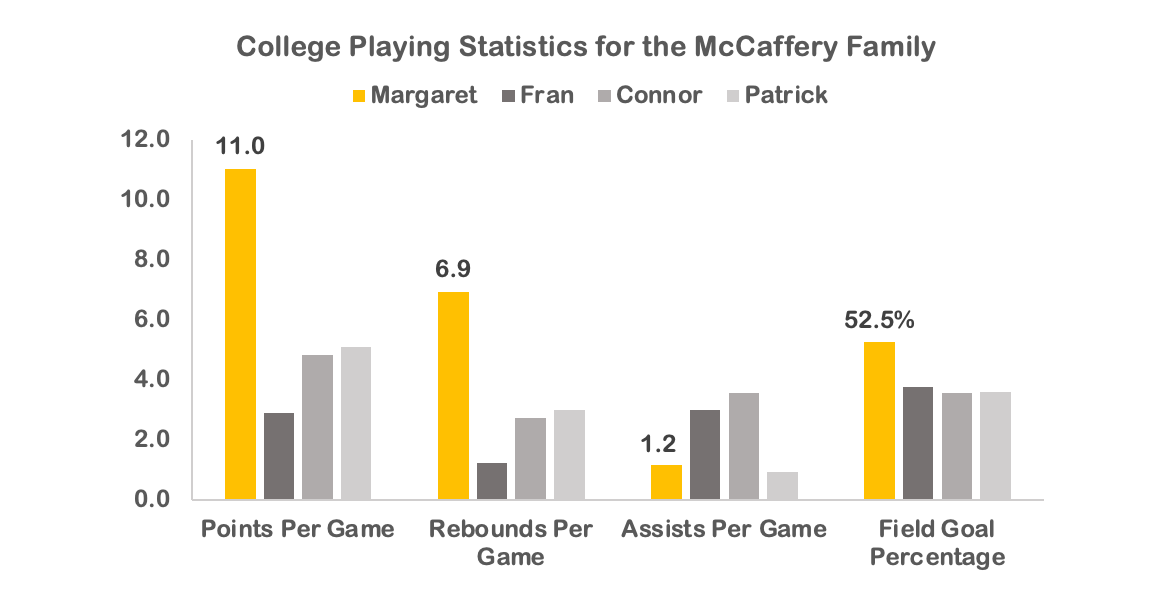Where Are They Now? Margaret Nowlin, Notre Dame Basketball (1988-92)
Catching up with the captain who led Notre Dame to its first NCAA Tournament
Thanks for reading the Her Hoop Stats Newsletter. If you like our work, be sure to check out our stats site, our podcast, and our social media accounts on Twitter, Facebook, and Instagram. You can also buy Her Hoop Stats gear, such as laptop stickers, mugs, and shirts!
Haven’t subscribed to the Her Hoop Stats Newsletter yet?

As one of Muffet McGraw’s very first commitments at Notre Dame, Margaret Nowlin led the Fighting Irish to new heights in the early 1990s. Nowlin—now known as Margaret McCaffery—still keeps in touch with her legendary head coach and considers her a friend. But on some days, McCaffery feels like she has more in common with McGraw’s husband, Matt.
“We will go back and forth about, ‘Oh my gosh, this is terrible. I don't know how you did this, Matt, for so many years,’” McCaffery told Her Hoop Stats. “… He's like, ‘Tell me about it!’”
The challenge McCaffery and Matt McGraw bond over is being the spouse of a Division I head basketball coach, as McCaffery is the wife of Iowa men’s head coach Fran McCaffery. As a former captain and standout player for the Irish, Margaret McCaffery is also one of the most knowledgeable and involved spouses in the sport.
McCaffery’s introduction to basketball came in about second grade, when her father mounted a hoop on the family’s garage in Minneapolis, Minnesota. It didn’t take much convincing, as McCaffery was “a total tomboy” who would play “anything with a ball”—including football against boys. She eventually grew to be 6-foot-1 but had some guard skills, including a face-up game and the ability to bring the ball up the court on occasion.
As a result, McCaffery was a top college prospect, taking official visits to Duke, Iowa, and UCLA along with Notre Dame. But Notre Dame was one of the first to recruit her, and she developed a strong relationship with then-assistant coach Bill Fennelly. She ended up committing to the Irish shortly after McGraw was hired in 1987.
When McCaffery got to Notre Dame, the staff asked her to play as a back-to-the-basket center. “I think [that] would be different now,” she said. “… If I had grown up now, I would have been a completely different player.” Even though it was a new role for her and she was sometimes undersized, she excelled, starting 100 of 119 career games and averaging 11.0 points and 6.9 rebounds per game. She also shot 53% from the floor and 71% from the free-throw line and added 1.2 assists, 0.8 steals, and 0.7 blocks per game.
“I'm really competitive by nature, so I wanted to win everything that we did,” she said. “… I think that my determination … came through and I was able to make up for some of that [height] deficit.”
Notre Dame did, in fact, win nearly every conference game in McCaffery’s first three seasons, with a cumulative record of 43-3 in the Midwestern Collegiate Conference and 67-27 overall. Controversially, in McCaffery’s junior season, neither a strong record nor being ranked in the AP Poll for nine straight weeks was enough to get the Irish into the 1991 NCAA Tournament. “That was devastating,” she said. “… It just felt really unfair.”
Her senior season provided some redemption, as the Irish weathered a tough non-conference schedule and secured the conference’s first-ever automatic bid to the NCAA Tournament.
“That was probably the most special part of my career and the best memory,” McCaffery said. “I remember going over and hugging Coach McGraw. I think I probably picked her up off the ground. Because we'd worked so hard for those four years … and what an accomplishment it was.”
It was also the first NCAA Tournament berth in school history, and although the No. 12-seeded Irish lost to fifth-seeded UCLA, it started the program’s run of making 25 of the next 27 NCAA Tournaments. Notre Dame advanced to nine Final Fours in that span and won national championships in 2001 and 2018.
After graduating with a degree in government, McCaffery played in the south of France for one season before retiring in part due to patellar tendinitis. She worked at the Legal Assistance Foundation in Chicago in preparation for law school while also coaching high school basketball. But just before she started classes at the University of Minnesota, McGraw called with an unexpected question: would she be interested in joining the Notre Dame staff?
McCaffery was enthusiastic, but she had a question, too: what did the basketball schedule look like for the upcoming season? McGraw replied that the team would open the season with a tournament in Hawaii. The answer proved pivotal—not just to McCaffery’s decision, but also to her future beyond that year.
McCaffery accepted the position and deferred her law school admission for a year. That season, McCaffery said, was when her relationship with McGraw began to evolve from player-coach to friends. It was also when she started dating her future husband, who was an assistant coach on the Notre Dame men’s basketball team. Their relationship emphasized basketball from the beginning: their first dates involved diagramming plays and attending an NBA exhibition game, and Fran eventually proposed to Margaret after a basketball game.
As planned, Margaret left coaching after one year on McGraw’s staff, but she opted to attend law school at Notre Dame instead of Minnesota to stay closer to Fran. She resumed legal aid work as a student, focusing on family law, and continued after graduation, including in her current role on the board of directors of the Iowa Legal Aid Foundation.
“I felt very passionate about [legal aid],” she said. “I'm from a family where service and activism and giving back and being a part of a community that you live in was a priority always. And so I took that example from my grandmother, my aunts, my parents, and my other grandparents—all of them.”
Margaret’s decision to leave coaching wasn’t complicated, even though she enjoyed her stint with the Irish. “My husband always said, ‘Oh, you should have kept coaching,’” she said. “But we never would have seen each other.”
Instead, she remains involved and invested in the game through Fran and her children—two of whom, Connor and Patrick, currently play for their father at Iowa. All four children have at least dabbled in basketball, even though Margaret said she and Fran never pushed it, and both parents reportedly coached their children’s youth teams. The oldest, Connor—whom Margaret had carried as an infant across the stage at her law school graduation—was just as eager to play as Margaret had been as a child.
“It was in him from day one,” Margaret said, recalling Connor’s infatuation with the plastic hoop the McCafferys had in their garage in Greensboro, North Carolina, where Fran coached from 1999 to 2005. “I'd have to introduce the starting lineup of the UNCG Spartans, and he'd come running in and go dunk or go through the layup line.”
Connor wanted to be around the sport so much that he attended practices with Fran starting in kindergarten, and he later served as a ball boy for Iowa in the NCAA Tournament. In contrast, Patrick was initially more likely to show up at Fran’s practices in a Power Rangers costume, as he preferred acting out stories to playing sports. But he soon fell in love with basketball, and youngest child Jack followed. (Their sister Marit has focused more on community service, like her mother, and golf.)


Margaret’s world turned upside down when Patrick, then a seventh-grader, was diagnosed with thyroid cancer in 2014. She spent a year focusing primarily on caring for him, including a span in which he had to take iodine pills to kill any remaining cancer cells after having his thyroid removed.
“In effect, he became radioactive and had to remain isolated in the basement,” the Iowa City Press-Citizen reported in 2017. “Fran, Connor, Jack and their sister, Marit, moved to a hotel for a while. After a few days, Margaret could be in the same room as Patrick, but she had to stay at least 6 feet away. Everything Patrick touched had to be thrown away. Clothes, sheets, pillows, video game controllers.”
Patrick was eventually declared cancer-free, and the McCafferys devoted a lot of their philanthropic efforts to fighting cancer. They helped start the Adolescent and Young Adult Cancer Program at the University of Iowa Hospitals & Clinics and currently hold an annual gala to raise money for cancer-related causes. Between 2013 and 2019, the McCafferys helped raise $2 million to fight cancer, and in 2018, Margaret joined the board of directors for the American Cancer Society.


Although Margaret’s decision to give up coaching was straightforward, she admits that being a coach’s wife is challenging for her. “It's excruciatingly painful to watch,” she said of her husband’s games. “… When you're a player, you're in control, to the extent that you can control things that happen on the court. You at least feel like you can. And when you're a coach, you can at least talk about what's going on and feel like you have something to say. … As the wife, you [just] have to sit there.”
She has occasionally struggled with that in the public eye, getting ejected from a game in 2006 and making headlines for criticizing the officiating after a game two years later. But she has also found her footing behind the scenes, greeting and supporting the players in the tunnel or the locker room after games and talking basketball with Fran at home.
“We have fairly sophisticated discussions and I have input,” Margaret said. “I don't feel like I'm not part of the game anymore or anything like that. I've continued to feel like I'm pretty involved. Not that I know play calls or things like that, but we talk about personnel and different things that people are doing, especially with his post players. …
“There have been a few guys where I wanted to explain to them how you really should be posting up.”
In 2017, Margaret’s role got more complicated, as Connor joined the Hawkeyes as a freshman. He had been committed to Iowa for three years, so the transition was hardly unexpected, but it took some getting used to on all sides. Margaret said she “tried, but not super successfully, to hold my tongue” about Connor’s lack of playing time as a freshman. “Sometimes I overstep and I have to rein it in,” she admitted. And she recalled one night when tensions boiled between player and coach—at the same time as she and Fran were slated to have dinner and see a movie with friends.
“I get a call from Connor as Fran's walking into the restaurant,” Margaret said. “And he's like, ‘You better tell dad to go find another point guard. I’m not going to play for him.’ … I hang up the phone and then Fran says, ‘Your son at practice today ...’ And I'm just like, oh, God.”
Margaret tried to calm each of them down but ultimately left it up to them to reconcile. From then on, they have worked together extremely well. Connor has started every game over the past two seasons, leading the nation in assist-to-turnover ratio last season as a redshirt sophomore. “They think the game in such a similar way,” Margaret said. “… Connor just gets what Fran wants and he sees it, and sometimes maybe even sees it before Fran sees it because he's on the court doing it.”
Meanwhile, Patrick is averaging 5.4 points in 14.8 minutes per game off the bench this season. “I'm a lot like most parents,” Margaret said. “Like, you want the team to win, but you want your kids to play well. And … I think they're finding their stride.”

Even with all the success Fran has had—over 450 wins in 25 seasons—the demands of the season and the family’s complicated schedules can take a toll on Margaret. When it becomes too much, she heads to her family’s cabin on a lake in Minnesota, next door to the house where her grandmother lived for most of Margaret’s childhood. “Fran calls it my happy place,” Margaret said.
The appeal of that lakeside getaway is why Margaret doesn’t consider herself a “basketball junkie,” even though it is often on television at home and is a frequent topic of family conversation.
“Do I consider myself a junkie? No. Would an outside person … dispute me on that? Yes, probably, because it just is such a big part of our life.”
Decades after she hung up her basketball shoes, Margaret remains an equally big part of Notre Dame women’s basketball history as the captain who led the Irish to their first NCAA Tournament and helped set the stage for the program’s subsequent success. And although her foray into coaching didn’t last long, she is rarely far from the game, just as competitive and tenacious in her role as a basketball wife and mother as she was in the paint.
“Where Are They Now?” is a series by the Her Hoop Stats team that spotlights former women’s basketball players, their athletic careers, and what they have gone on to do since retiring from playing. Players previously featured in this series: Kelley Hunt (UConn), Suzie Miller (Harvard), Tonya Burns-Cohrs (Iowa State), Sam Quigley (DePaul).
Thanks for reading the Her Hoop Stats Newsletter. If you like our work, be sure to check out our stats site, our podcast, and our social media accounts on Twitter, Facebook, and Instagram.




